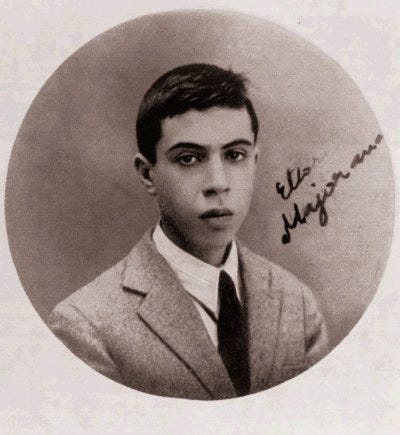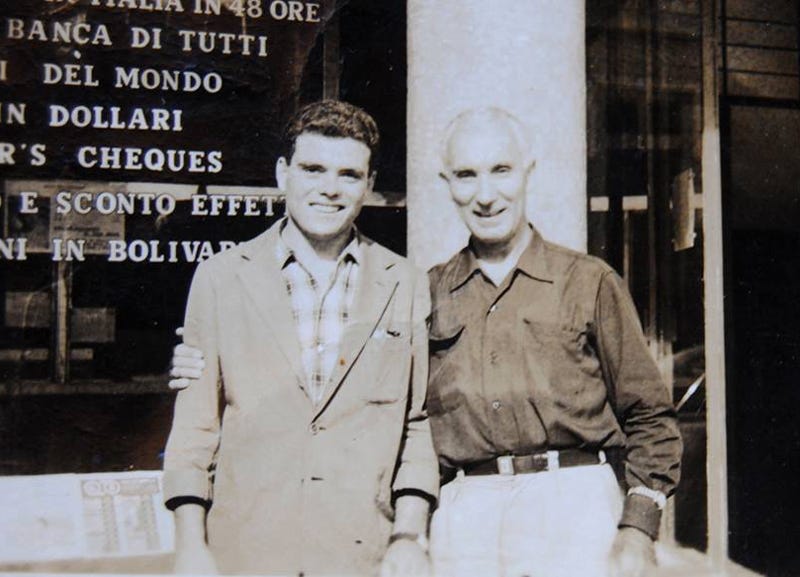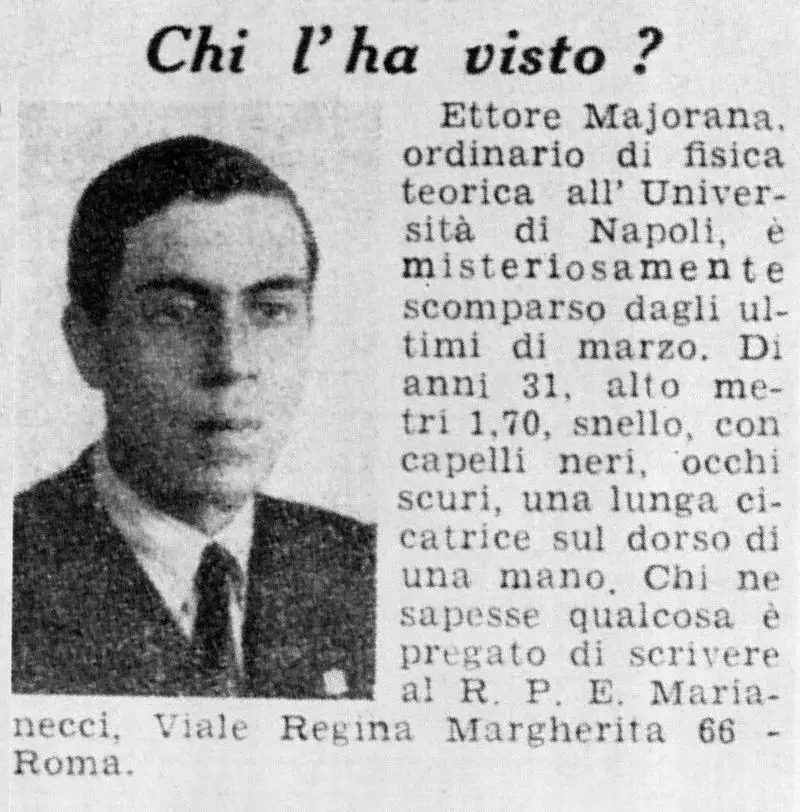 ave you seen this man?”, the Italian newspaper Domenica del Corriere asked its readers on July 17, 1938. The photograph of the missing young professor Ettore Majorana — black hair, droopy eyes, pale, ordinary-looking face — suggested a dull, colorless substitute teacher who slaved away unnoticed in a small country school.
ave you seen this man?”, the Italian newspaper Domenica del Corriere asked its readers on July 17, 1938. The photograph of the missing young professor Ettore Majorana — black hair, droopy eyes, pale, ordinary-looking face — suggested a dull, colorless substitute teacher who slaved away unnoticed in a small country school.
31-years-old Ettore was anything but colorless: he was a brilliant physicist and exceptionally talented mathematician, sought after by some of the best-ranked universities in the world. Enrico Fermi — the father of the nuclear age, who was his friend and mentor — described him as “the greatest theoretical physicist of his time.”
The Sicilian-born Ettore was a child prodigy — an anomaly, with an almost super-human capacity for mental calculation — but he was also painfully shy, intensely secretive, and (as novelist Leonardo Sciascia wrote, and everyone who knew Majorana agreed on) a very weird young man.

Absent-minded genius
Fermi considered Majorana “a sheer genius, in the same league as Galilei and Newton” but he remarked that he “completely lacked common sense”.
Ettore was indeed a man of a strange disposition, and would walk or ride a bus in complete silence, frowning, lost in thought; then he would rummage his pockets, retrieve a pencil and start writing down the most complex of formulas on the back of a cigarette pack. He then often crumpled the pack up and threw it away.
He was invited to work at the Universities of Cambridge and Yale, but refused both offers. He would not leave his house for long periods of time, not even showing up at the University of Naples where he had been assigned a teaching position on grounds of his “outstanding reputation”; he would work twelve hours a day on his calculations, but then he would tear his notes up and throw them in the trash in the evening.
It was Majorana who first proposed the existence of neutrons, but he neglected to publish his ideas (James Chadwick would later win a Nobel Prize for discovering the neutron).
He also extended much of Enrico Fermi’s work and made several key discoveries himself, especially in the field of atomic spectroscopy; but any time he found himself on the brink of a scientific breakthrough he would retreat into his shell and refuse to seek credit for his discoveries.
“I don’t care,” he would say, shrugging, when Fermi urged him to publish his work. “It’s not interesting.”
Majorana would often obsess about minute details of his calculations to the point he completely failed to see the big picture: once, during an exam, he sketched a geometric figure that was correct in every way, except that it was absolutely microscopic and drawn diagonally in the corner of a gigantic sheet of paper. The teacher, rather irritated, asked him if he was trying to be funny. Majorana was taken aback: he had simply not realized he had all that space available to him, he explained.

Not the funniest guy in the room
Besides being so hyper-focused on his work to end up completely unaware of his surroundings, Majorana didn’t exactly have great social skills.
At all.
The first time he and Fermi met, the latter showed him the broad outline of the model of the atom he was working on — which was groundbreaking at the time — and the table showing the numerical values of the so-called Fermi universal potential.
Majorana listened intently but said nothing, and went home without giving any indication of his thoughts — leaving Fermi rather dumbfounded.
The next day he barged in unannounced in Fermi’s office and, without even saying hello, he brusquely demanded to see the model he had been shown earlier. He then took a tiny folded piece of paper out of his pocket and showed it to Fermi: it was the same table he had seen for a few minutes the day before, that he had re-calculated overnight.
He soon started working with Fermi and the Boys of Via Panisperna, the gifted young scientists whose discoveries would lead to the construction of the first nuclear reactor and the atomic bomb. His coworkers soon nicknamed Majorana “The Great Inquisitor” (in the same vein Fermi was called “The Pope”) for his frequent and inexorable criticism.
For instance, while Fermi (a Nobel Prize in Physics and one of the most brilliant minds of the 20th century, so not exactly an idiot himself) delivered a lesson, Majorana would often interject with something like “Why would I be interested in that? That’s below me” or “That’s such a childish way to do things. I would do this instead,” and proceed to illustrate his own calculating process.
He was not trying to be flippant: he just had no filter whatsoever. Fermi never took offense (he actually grew to be very fond of young Ettore), but soon started giving him private lessons to avoid trouble with the other students.

The Geman interlude
In early 1933, at the suggestion of his mentor Fermi, Majorana went to Nazi Germany to work with famous physicist Werner Heisenberg, unconcerned that he could potentially face racial persecution (Majorana’s father was a Jew). He also briefly worked with Niels Bohr in Copenhagen.
When he came back to Italy, in August 1933, his friends and colleagues noticed he had become even more withdrawn and reclusive than before: he was hostile to family and friends and largely shut himself off from just about everyone he knew.
At the time he was working tirelessly on something, but nobody — not even his closest friends — knew exactly what that was. They all noticed, though, that he often looked upset. “We’re on the wrong track” he would say. “Scientists are wrong, all of them.”
But what exactly they were wrong about, he would not say.

In 1938 he wrote a strange and worrying note to his close friend and fellow professor Antonio Carrelli. It read: “I have come to an inevitable decision […] I know my sudden disappearance will cause some trouble to you and the students. Please forgive me for letting you down,” and went on saying he would cherish the memory of all his friends at the university “at least until 11 tonight, and possibly even after that.”
Weirdly enough, he asked his friend to give his regards “especially” to a student of his named Sciuti — a young man he was not friends with, or close to at all — but failed to mention any of his old friends and colleagues. This later sparked rumors that Ettore was secretly infatuated with the student.
He wrote a second letter to his family members asking them to “please don’t wear black [to his funeral]” and, again, to forgive him. He apparently changed his mind almost instantly, because the very next day both his family members and his friend received a telegram simply stating “Don’t worry. A letter will follow. Majorana”. This left them all utterly confused, given that the farewell letters had yet to be delivered.
On a later date, he cryptically wrote to Carrelli, “The sea rejected me and I’ll be back tomorrow […] I’m going to leave tuition. I am at your service to explain everything.”
A mysterious disappearance
But he never got a chance to explain anything to anybody: that was the last time anyone heard from him. He vanished a few days later, somewhere between Naples and Palermo, and — interestingly enough — it was soon discovered he had withdrawn a large amount of money from his account and took his passport with him.
Some of his friends were sure he had committed suicide or escaped to a monastery to live in reclusion; others thought that he may have defected to the Soviet Union. For some time it was suspected he had been kidnapped by Nazi officials in an attempt to force him to build nuclear weapons for the German army; even the possibility he had been murdered by the American secret services was taken into account.
Benito Mussolini himself, who at the time was at the heights of his power, took great interest in his disappearance: he allegedly wrote I want him found! in large angry letters on Majorana’s police file.
Enrico Fermi persuaded the Duce to offer a reward of 30,000 lire (a colossal sum at the time) to anyone who would report any useful information about the disappeared physicist. Nobody ever came forward, and his disappearance remained an open case for more than 70 years – until it was reopened in 2011 following a new, unexpected lead.

The end of a mystery…
In 2008 a man named Roberto Fasani came forward on a popular tv program with a faded, sepia photograph dating back to the 1950s. The picture showed two people standing in front of a shop window: a young man — Fasani himself — and an older fellow with hollow cheeks and thinning white hair.
Fasani made a mind-boggling claim: the white-haired gentleman in the yellowed picture was Ettore Majorana, living in South America at least until 1959 under the assumed name, “Mr. Bini”.
Fasani remembered that the man was remarkably shy and avoided having his picture taken like the plague: he only agreed to take that one picture, after much prodding, in exchange for a loan of 150 bolivars he really needed to get.
A friend of Fasani’s once revealed to him the reason for all the secrecy: “Don’t you know who that man really is? He’s some sort of genius scientist. His real name is Majorana.”
After the picture was made public, other people came forward, maintaining they met Bini/Majorana in Argentina, and later in Venezuela: his real identity had apparently been an open secret there.
Those statements made national news and prompted the Rome Attorney’s Office to reopen the case; the forensic section of the Italian police compared photographs of young Majorana and Mr. Bini and an extensive investigation followed. In 2015 a statement was released, ruling that Majorana was living in Valencia, Venezuela, between 1955 and 1959.

… or the beginning of a new one?
In spite of the official police statement, much remains to be explained in Majorana’s mysterious disappearance.
Were Mr. Bini and Ettore Majorana really the same person?
When (and how) did Majorana end up in South America?
Why did he never try to contact his family members — especially his mother — who kept desperately looking for him for years?
And, last but not least: what drove him to disappear and leave behind his whole life?
The only thing that remains for certain is a sense of frustration for all the things his extraordinary, extraordinary mind could have produced, and the amazement at the way he vanished like a shadow one cold Italian night in March 1938.

30-something, born and bred in Italy. If you leave me unattended in your house I will sand down and repaint every piece of furniture you own. Can’t parallel park to save my life.





